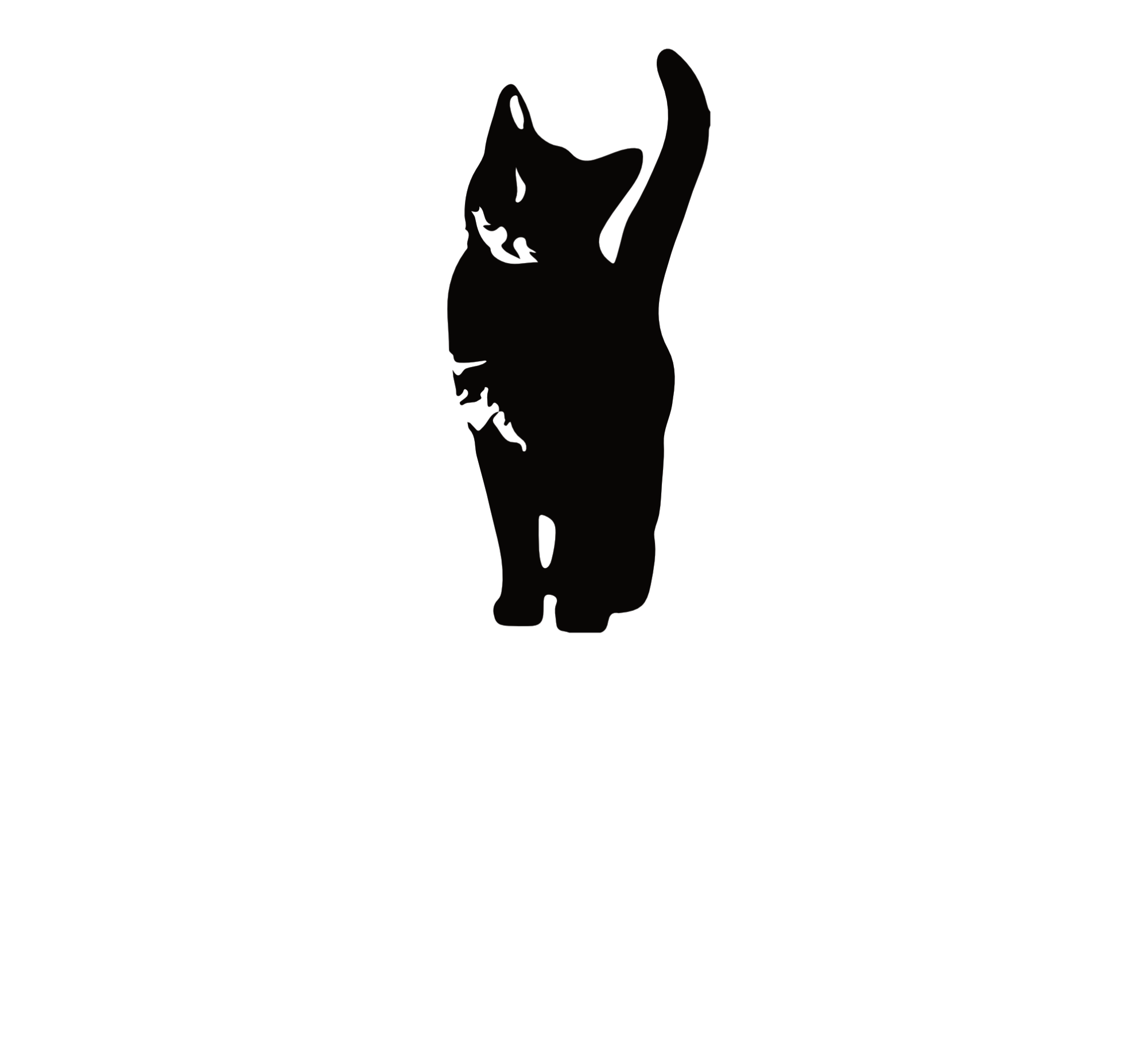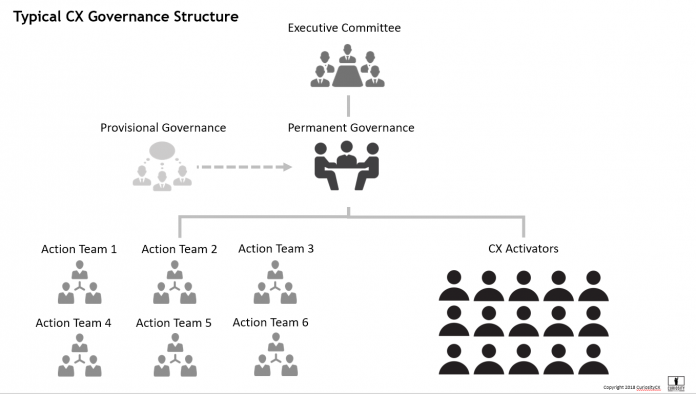Have you been handed the reins of the Customer Experience (CX) program at your company and have no idea where to start? Need to radically overhaul your existing program in a hurry? Here is a list of 6 steps to get rolling in your first 100 days.
Step 1: Establish Governance
The first step in any endeavor is to get organized. You may be tempted to just start running around and kicking off a bunch of initiatives, but resist that urge. That approach rarely has a lasting effect other than creating chaos and eroding your credibility.
In getting organized you need to set something called governance. It is a scary name for a simple idea; organizing your organization on how to approach customer experience. Many studies support the notion that without C-level support no CX initiative will succeed. So that is a pre-condition. Grass roots CX initiatives do not work.
With that in mind it is time to get provisional governance together. This is simply a committee of people who all have an interest and a hand in impact customer experience in your organization. It is your job to recruit these folks.
Your provisional governance be a good mix of geographies and functional areas. They should be senior enough to have authority, but not so senior that they don’t know the mechanics of their area.
While there is no magic number, 5 is probably too few and 20 is probably too many. 8-10 people is usually the ideal number to maximize span of influence but not allow diffusion of responsibility to flourish. Once you have gotten your team of recruit on-boarded, it now important to figure out what it is you want to do.
Do This:
Do you have some assassins lurking in the shadows at senior levels? These folks should be your highest priority in recruitment to your team. This seems counterintuitive, but the Stockholm effect is a powerful force. Make them part of the solution and they will have ownership in the outcome. Even assassins don’t want failure on their resume.
Don’t Do This:
You may be tempted to just invite other member of your own tribe to your CX party. This is a sure-fire way for the CX program to fail before it even starts. You must reach across the aisle and get a broad representation in the provisional CX.
Step 2: Define Goals
Next it is important to establish what is that the organization wants to do about CX. It defines the rules, the boundaries, and the mandate into the future. The main objective of the folks in your governance committee is to bang out a charter. The charter defines:
- What are goals of the governance committee
- What are task that need to be accomplished to achieve those goals
- What is in and out of scope
- Who is responsible for doing what
- What are the resources and timeline for getting it done
It is essentially a plan for getting a plan together. It doesn’t have to be long or formal, just something that adequately communicate and aligns the group to the task at hand The group must approve this charter and the executive committee at your company should also ratify it for it to have any credibility.
Do this:
Make it simple and non-technical. Ensure you don’t overthink it and that you have full agreement amongst the group. No hung juries please! Also, I am a big fan of timelines with names and dates. Enforcing this accountability tends to be helpful in getting things done. Again, no one wants to fail.
Don’t Do This:
This document should be completed in no more than 3-4 one-hour meetings. Better yet hold an off-site and just crank it out in an afternoon. If it is taking longer than that you are doing something wrong. Depending on your organization’s culture you may want to a formal or informal presentation to your executive committee. Their formal approval is, however, important to move forward.
Step 3: Rally the Troops
Committees rarely inspire anyone. Therefore, effective and inspirational communication is absolutely critical in the initial stages and it should consistently implemented throughout the process. This is an on-going internal marketing campaign. The usual tempo of communication is to first communicate what is that the organization is doing and why it is important to the future of the business. This shouldn’t be a “project” or “initiative” it is a change in strategic direction if it is to be successful. That means ….yes…cultural change.
Also, you need a “burning platform” to help motivate (sometimes scare) folks to action. The burning platform focuses on getting people to understand that the risk of not changing is much higher than the risk of staying the course. For example, almost every vertical is under assault from someone trying to “disrupt it”; from automotive to pharmaceutical there is no place to hide. The burning platform case shouldn’t not be overly difficult to develop.
Some key elements of a successful internal CX campaign can be found in the three “E”s:
- Excitement – make sure you are getting your executives to communicate out the importance and what is going on. Enlist front line employees in helping raise understanding of the emphasis around CX. They will also form part of your governance as “Activators” in the field. Get people stoked to be a part of it. The key here is to generate awareness and excitement.
- Educate – if you are changing toolsets, processes, or policies I simply and very clear education is essentially. Simply rolling out a tool and hoping for the best is a great recipe for waste. You must train people on new tools, processes, and policies. Seems straight forward, but this is an area that is often over looked.
- Engage – the last step in the communication strategy is in getting people engaged with the new changes. Training types like to call this “behavioral transfer” from the classroom to the real world. Some approaches can be gating sought after capabilities, implementing recognition programs, and holding people accountable to metrics
Do this:
Ensure the first communications have the unambiguous backing of your senior executives, ideally your CEO or President. They need to be present and walk the walk. Make your communication very simple and very clean. A rallying cry is always helpful. For example, a utility used sport awards to recognize employees who do an especially good job with customers. Clever integration of brand with employee recognition can go a long way.
Don’t Do This
Stay close to the troops and get and walk amongst them. Communication plans that are clinical and overly corporate activate employees’ bullshit detectors. You must be genuine, simple, and consistent. Make it about them, not you.
Step 4: Conduct Rapid Journey Mapping
Usually the next thing on the list to get done is to gain a better understanding of your customers and prospects. Journey mapping is a helpful tool to do so, but not the big arduous process that some might propose. Initially you need to move quickly.
Rapid journey mapping will help center your organization, but do so without absorbing months of work while the organization waits for results. I recommend starting simple in journey mapping sticking to a qualitative approach first and validating later with a quantitative approach. The steps are straight forward
- Establish who the customer is: is it one group or several? Do they take pretty much the same journey or completely different ones? If there are distinct groups start with the core customers of your business first.
- Get your provisional governance team together to sketch out what they think the customer journey looks like. You may want to extend attendance to others to maximize engagement and inclusion.
- Talk with some customers. You can do this yourself or get outside help. This will be eye opening for the entire team as the external view is usually a bit different from the internal view.
This process sounds a bit like research to understand the customer journey, but that is only one outcome. The larger, and more important outcome is to start knitting siloed departments together. This is increasingly import as e-commerce and retailing intersect and oftentimes create a haphazard and miserable experience for your customers. Journey mapping and governance is the foundational work in getting functional or product centric organizations to work as customer centric organizations.
Do This:
Stay simple and with the core of your business for the journey mapping exercise. The finished map doesn’t need to be a master piece, it is a communication tool for the team to action on initially. You can pretty it up later. The main outcome is to establish a shared and aligned understanding of the customer journey amongst stakeholders.
Don’t Do This:
Avoid rabbit holes or “spurs” in the customer journey. You don’t need to visit every 1% incident activity or things that affect few customers. Don’t get overly obsessed with details or create process maps. This is about the customer experience from their standpoint.
Step 5: Act!
The famous WWII general George Patton once said, “A good plan violently executed now is better than a perfect plan executed next week”. I fully agree.
Quantitatively validating your journey map is important, but your early rapid map usually reveals some glaring issues early on that you can jump on. It provides a rough idea of problem and opportunity areas so now it’s time to triage. The criteria you should use in deciding what to do are:
- What is the risk/cost of not doing something on each issue?
- How difficult will it be to address?
- What is the likely impact of addressing the issue?
For each issue give a rating across these three criteria of High, Medium, or Low. Then sort it the list. Stuff that having a large negative impact today, that are easiest to fix, and will have the biggest future impact float to the top. Hard stuff with minimum impact float to the bottom. This will give you a rough roadmap from which to start implementing changes.
The items on your list can then be handle by action teams who have the appropriate representation. For example, for billing problems you probably want to have e-commerce, accounting, finance, and operations involved in solving the problem. The action teams are temporary. After they address the problem they can disband, unless there is a need to iterate and optimize.
Do This:
Small, quick and incremental interventions can help move things along and mitigate risk. These are critical elements at the core of the Agile CXTM which is to thread as many idea beads down the innovation string as possible and get them to test market. Implement them and observe the outcome. Roll out the good ones more broadly, toss out the bad ones, and modify and retest the ones that have hope.
Don’t Do This
Don’t over analyze the problem and get stuck in a debate cycle. Also, don’t take too big of a bite which gets stalled in the organization. For example, overhauling the CRM or ERP system as a first project is probably not a good idea. Perhaps there is something as simple as a hard to understand bill and complicated form that can be corrected. Stay small, fast, and nimble.
Step 6: Adjust and Keep the Momentum
You’re not going to get it right the first time, so don’t be too hard on yourself. Prepare your executive committee for some wrong turns and missteps. It’s going to happen. Long term sustainable change is a marathon not a sprint, so you will need distance runners at your side.
Celebrate the victories and make them public. Admit the missteps and adjust. Your CX program is a living breathing undertaking not a program to rammed down from on high. A practitioner-professor of mine once told me that organizations are sailed not driven. I think there is much wisdom in this.
You need to lead by coaxing and cajoling not mandating and punishing. People will make up their mind if they want to follow or not. You just need to provide the incentives to do so and make it easy for them. Invite them in and make them a part of it. I wish the best of luck to you in sailing your organization and if you need some help in navigation or tying (or untying) a few knots let me know.




